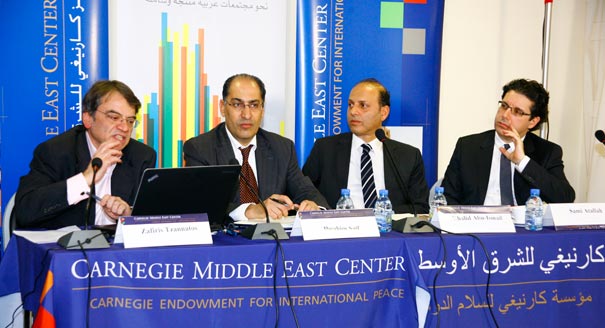Registration
You will receive an email confirming your registration.
Although Arab economies are plagued by unemployment, income stratification, and worker inefficiency, creating productive and inclusive societies can help lift the region out of poverty. A new report by the International Labor Organization (ILO), the United Nations Development Programme, and the United Nations Economic and Social Commission for Western Asia (ESCWA) explores the economic changes that have taken place in the Arab world over the last two decades. The report examines the implications of economic growth and its uneven distribution between and within Arab societies.
The Carnegie Middle East Center hosted Zafiris Tzannatos, an economist based in the UAE and former senior advisor for the ILO Regional Office in Beirut, Khaled Abu Ismail, a senior economist at ESCWA, and Sami Atallah, the executive director of the Lebanese Center for Policy Studies, to discuss the report’s findings. Carnegie’s Ibrahim Saif moderated.
Findings
Tzannatos began the discussion by highlighting the report’s findings:
- A Veneer of Socialism: During the 1980s, the Arab world was modeled on a paternalistic and autocratic system under the banner of socialism. The state provided many jobs and benefits for public sector employees, yet the system maintained limited social participation, said Tzannatos.
- Extremes: This period in Arab economic history was marked by two extremes, he added. On the one hand, liberalization and pro-market reforms had great effect. However, these policies did not exactly produce the desired results and their impacts led, in many respects, to the emergence of the Arab Spring in December 2010.
- Uneven Distribution: While the Arab world grew faster in terms of employment than any other developing bloc, the distribution of growth to certain sectors has been unimpressive. Likewise, the social conditions of the working poor have not improved, Tzannatos argued.
- Unbalanced Growth: Despite continuous poverty reduction up until 2010, it did not keep pace with the region’s high GDP growth rates over the last three decades, Tzannatos continued. The region still fared well in terms of social development, a sharp contrast to the low scores on governance indicators. Growth has mostly benefitted low value-added sectors and activities, which explains the sharp rise in informal economies across the Arab world, he added.
Dispelling the Myth
Tzannatos argued that there are several distracting myths about Middle East economies.
- Jobless Economic Growth: Tzannatos said that the claim that the Arab region had economic improvement without job creation was invalid, even if the kind of work being created was low skilled.
- Booming Youth Population: Arab nations actually have maintained a relatively constant percentage of youth vis-à-vis the general population during the last three decades, noted Tzannatos. And despite a growing labor force, the rate of growth has actually declined which has eased demographic pressures in the region.
- Youth Unemployment as the Catalyst for Protest: While youth unemployment played an important role in sparking the Arab Spring uprisings, political grievances were a major component of calls for societal change, he added.
Constraints Facing the Region
Ismail highlighted three socio-economic challenges facing the Middle East and North Africa:
- Investment: The MENA region has witnessed the lowest investment rates in the world, both before and after economic reforms began taking hold in the 1980s.
- Institutional Problems: Institutional limitations, including rampant corruption, a lack of stability, and little access to land, have severely constrained private sector development.
- Skills: The Arab world has intense skill set shortages and mismanagement of existing skills.
Recommendations for Improvements
Atallah offered four steps for building productive and inclusive Arab societies:
- Further research on the causes of low youth entrepreneurship in the region.
- More research on the impact of trade liberalization policies, since the effects of a reduction in barriers to trade on productivity and social development have not been adequately studied.
- A comprehensive examination of why the private sector’s demand for skilled laborers has actually decreased.
- A policy approach that is more targeted and focuses on the specific needs of each sector or industry.
